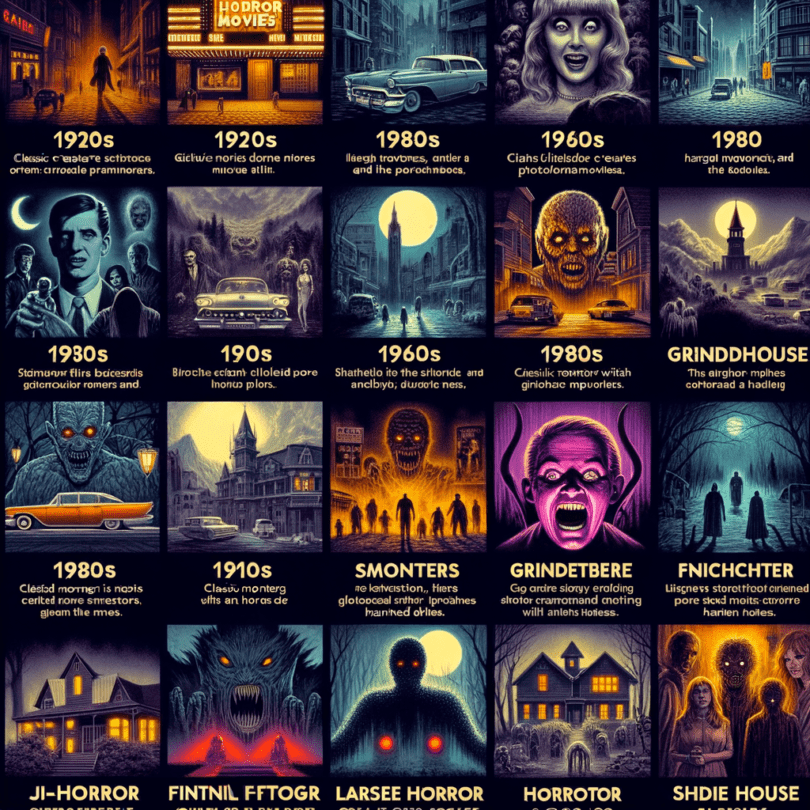Oh man, where do I even start? Horror films have been this wild ride I’ve been on for as long as I can remember, filled with adrenaline-pumping drops and heart-stopping thrills. I have this weird mix of awe and nostalgia when I sit back and think about how this genre has grown up over the years. It’s like flipping through an old scrapbook, filled with memories that both terrify and delight me.
The Birth of Horror in Cinema
Okay, imagine yourself way back in time, during the silent film era. It was then that horror first crept into movie theaters. Those flickering, scratchy, black-and-white films, paired with eerie music—totally silent but absolutely spine-chilling. I’m talking about classics like “Nosferatu” (1922) and “The Cabinet of Dr. Caligari” (1920). They were like the great-great-grandparents of today’s horror flicks. Honestly, there’s something so charming about these early films—the innocence in the fear they evoked. They were all about atmosphere, pulling fear straight out of the shadows.
1930s to 1950s—The Age of Monsters
We stepped into the era of sound films and horror found its growl. The 1930s gave us the iconic Universal Monsters—Dracula, Frankenstein’s Monster, The Invisible Man—oh, they weren’t just movie characters, they became legends. Imagine the collective gasps in theaters as these creatures first appeared onscreen, making audiences clutch their armrests in terrified anticipation. But then came World War II, and the real-world horrors put these fictional fears on pause for a bit. By the 1950s though, horror found a new buddy in science fiction. Think nuclear monsters and alien invasions—films like “The Thing from Another World” (1951) and “Invasion of the Body Snatchers” (1956) played off society’s anxieties, creating terror with a twist of reality.
The Swinging ’60s: Psychological Thrills
Fast forward into the 1960s, and horror takes a turn inwards. The psychological aspect of horror movies from this time is just mind-blowing. Hitchcock nailed it with “Psycho” (1960)—suddenly it wasn’t about monsters, but the horrors lurking in our own minds. And let me tell you, the famous shower scene? Even just saying ‘shower’ gives me the creeps. The idea that humans are capable of such darkness hit a nerve, showing that sometimes, the most terrifying monsters are those we can’t see.
The 1970s: A New Wave Emerges
The ’70s were absolutely batty when it came to horror. Things got gritty, raw, and unapologetically intense. Remember “The Exorcist” (1973) with its chills and thrills or “The Texas Chainsaw Massacre” (1974) ramping up the shock factor? These films shattered the boundaries of fear. They practically shouted, “Here comes the scary!” I’m just blown away by how unflinching they were—reminding us that horror could be anywhere and everywhere.
Welcome to the ’80s: Slasher and Supernatural Frenzy
Ah, the ’80s. What a time to be alive! Neon everywhere, big hair, and horror films that became a rite of passage. This was the era of slashers—Freddy Krueger, Jason Voorhees, you know the crew. There was almost a comforting predictability to a slasher film: just follow the rules and avoid every shadow. But scare-wise, supernatural horror jumped in too—remember “Poltergeist” (1982) and “The Shining” (1980)? There was something undeniably magical about this mix of thrills and suspense. Heck, I spent so many nights watching through my fingers, glued to the screen.
The ’90s: Reviving and Reimagining the Horrors
Here’s to the ’90s—where horror films got a snazzy revamp. The “Scream” franchise (starting in ’96) cleverly played with the genre, breaking the fourth wall and winking at the audience. Horror became refreshingly self-aware, poking fun while keeping us scared out of our wits. But more than that, this was also when psychological thrillers mixed in, like “The Sixth Sense” (1999), blending fear with narrative depth. Blood and gore weren’t the only tools—emotion and drama found their place in the horror toolkit, satisfying those of us yearning for more than just blood splatters.
Into the New Millennium: A Surge of Remakes and Found Footage
Ah, the 2000s—with their wave of remakes and the birth of the found footage phenomenon. The “Blair Witch Project” (1999) started it all, making fear feel uncomfortably real and raw. Sitting in a theater, heart pounding, watching shaky cam footage—it was like being right there in it all. Fear felt palpable, immediate—like it was made just for me. This era danced the line between fresh ideas and nostalgia, keeping all of us horror fans guessing.
The 2010s: Horror Explored New Depths
Then came the 2010s—where horror telescoped into depth and meaning. Films like “Get Out” (2017) and “The Babadook” (2014) transformed into more than just scares; they were conversations wrapped in shadows, diving deep into societal issues. Horror became this introspective journey, an art form that dared audiences to think and ponder alongside the screams.
And oh, the indie films—they ventured into fresh narratives, mixing genres with an imagination that was exhilarating. There was this essence of creativity itching to be seen, inviting us horror fans to speculate and question amidst the terror.
The Present Day and Beyond
Here we are, in the now—2013 and beyond—and who would’ve thought that horror would keep its hold on us, continually evolving and redefining what it means to truly scare and entertain. Streaming platforms have unleashed a wide array of horror, making the genre way more accessible. From short shivers to epic nightmares, there’s a bit of everything for every fan’s taste.
Tech-wise, VR and immersive experiences are pushing us right into the heart of the horror. Imagine being IN the haunted house or tentatively peeking around a corner. It’s exhilarating and somehow comforting to be on this ceaseless ride.
It’s genuinely exciting being a horror enthusiast now—warm and fuzzy one minute, bone-chilling the next. As history shows, horror holds a mirror to our fears and anxieties, never shying away from creeping up on us, forever adapting to reflect our world’s ever-shifting shadows.

